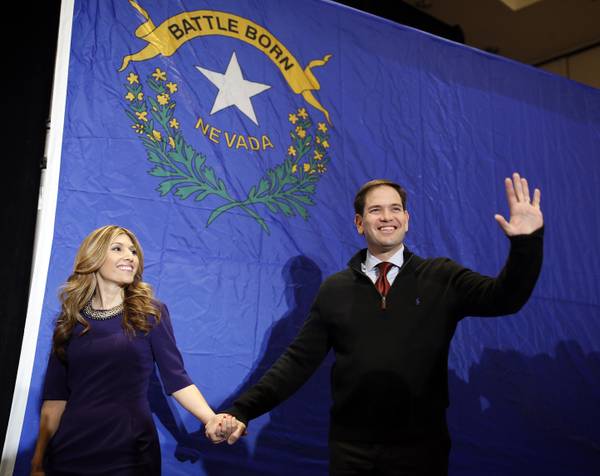Money is an easy measurement of business success. Life and death are clear signs of achievement for a neurosurgeon. Governors are rated by the laws they get passed and their state’s prosperity. Voters might use those yardsticks to choose between presidential candidates.
How do you assess the success of a candidate serving in the Senate? Bernie Sanders, Ted Cruz, Marco Rubio and Rand Paul are all seeking the presidential nomination. (Another, Lindsey Graham, dropped out last month.)
Even the most successful senators do not write many laws, and responsibility is dispersed among 99 other politicians.
A new analysis from Quorum Analytics, a firm that provides data-driven legislator profiles for lobbying firms, sheds some light on these legislators’ careers. What do they spend their time on? How often do their colleagues co-sponsor their legislation? How many votes do they skip? Some of the candidates, notably Jeb Bush, have tried to make a political issue out of Marco Rubio’s attendance record.
Quorum’s analysis compares the legislative careers of the four sitting senators running for president and tosses in statistics for Hillary Clinton, Barack Obama and Graham for comparison.
(For the statistics calculated after the candidates’ presidential announcements, Quorum measured Clinton and Obama 224 days into their 2008 campaign. It measured those in the current race as of Dec. 6, 2015, which was for Graham 188 days; for Sanders, 194; for Rubio, 237; for Paul, 243; and for Cruz, 258.)
Attendance: Since declaring for president, Rubio and Graham missed nearly half the votes in the Senate.
In 2008, however, voters did not seem to mind a young, ambitious senator skipping his day job to go on the campaign trail. At this point in that election, Obama had skipped 27 percent of his Senate votes, while Clinton had missed only 3 percent.
Cruz missed about 28 percent of the votes. Sanders missed only 14 percent. But Paul was the winner, at least by this measure, missing only 8.7 percent of the votes.
Talking: Even while speechifying nonstop on the campaign trail, Paul had more to say while on the Senate floor. Since declaring his candidacy, he has spoken more than 60,000 words in front of the C-SPAN cameras.
Graham preferred to save his words for non-C-SPAN television. He spoke only 8,000 words on the Senate floor during his presidential campaign.
Cruz comes in second to Paul at 48,000 words, but that’s about the same as Obama when he was running for president.
News Releases: Rubio, the top vote-misser, also leads in the number of news releases issued from his office. In the last session of Congress, he sent 923 news releases, more than every other senator in the chamber except one, Robert Menendez of New Jersey.
While running for president, Rubio has slowed down a little, but he continues to outpace the other candidates, with more than 230 news releases from his office.
Cruz came pretty close with 200 releases; the other active candidates were about half that.
Cooperating With Others: Senators draft legislation, but they need to have other senators support it. One way to measure how well they play with others is to look at co-sponsorships of bills.
More than half the bills introduced by Cruz and Paul while running for president attracted no co-sponsors from either party.
In contrast, only 10 percent of Rubio’s bills lacked co-sponsors. Over his five years in the Senate, Rubio has attracted the most consistent support from the other party, with over a third of his sponsored legislation receiving Democratic co-sponsors.
Less than 7 percent of Cruz’s sponsored legislation, by contrast, received any Democratic co-sponsors.
Passing legislation is a hard and slow process. Clinton got just three bills she sponsored into law during her eight years in the Senate.
None of the sitting senators currently running for president have passed more than two.
She sponsored more legislation per year than any of the Republican senators running for president (or Obama while he was in the Senate, for that matter).
In her Senate career, she sponsored 363 bills, an average of 45 a year. Cruz, in contrast, has sponsored only 46 bills total during his three years in the Senate.
Pandering to the Base: With the exception of Paul, every senator became much less congenial with members of the opposite party once the presidential campaign began.
As measured by the percent of bills from the opposition party that they co-sponsored, Cruz went to 12.5 percent from 19.4 percent, and Rubio stepped back only a bit to 32.7 percent from 38.2 percent. Sanders went to 17.1 percent from 22.2 percent.
A little benchmarking: Obama changed the most during the first several months of his presidential campaign. Before declaring his candidacy, Obama co-sponsored bills from Republicans about a quarter of the time.
After his announcement speech in Springfield, Illinois, that invoked the political courage of Abraham Lincoln, Obama began co-sponsoring only about 10 percent of Republican legislation.


Join the Discussion:
Check this out for a full explanation of our conversion to the LiveFyre commenting system and instructions on how to sign up for an account.
Full comments policy